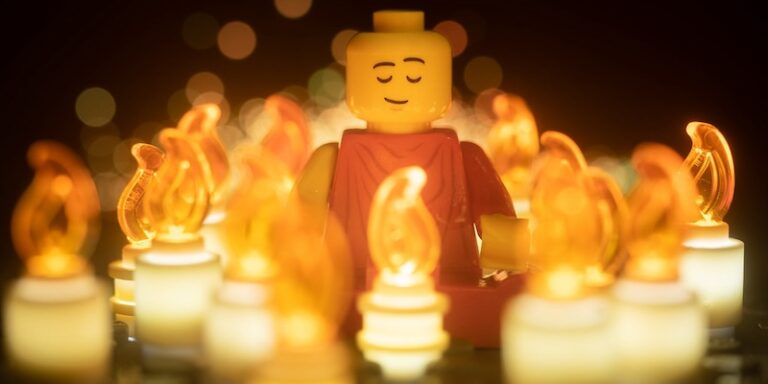I signed off on the pass pages for my sophomore novel in early February, six months before its August 13 pub date. Despite that gap’s obtuse quiet, I promised myself I wouldn’t spiral. is, after all, my second rodeo: I’ve done this before! I know how to temper sales expectations! (Though, like, *what if* my novel goes viral on TikTok?) I know to stay off Goodreads! (It is my third most visited page in Chrome.
) I know to distract myself by writing my next novel! (Creating one world while promoting another is, to put it mildly, disorienting.) Enter Legos. Yes, the tiny plastic blocks beloved by toddlers and loathed by barefoot parents.

Over the past two months, I have built five robots, three helicopters, two sharks, a speed boat, a science lab, the Super Mario villain Bowser’s muscle car, a tractor, and Hogwarts, to name a few. These little creations have been my balm, my saviors, my beautiful distractions. My foray into the land of Lego zen was somewhat accidental.
My older recently turned five and is obsessed with his builds. I had previously relegated Lego duty to my husband: he preferred the block activities and I preferred the imaginary play ones. And then, I got my first trade review.
It was curt, a touch misanthropic, and utterly devastating. A younger version of myself would have done something destructive, like parked at the bar across from my apartment and downed two martinis while wallowing. As the parent of a three- and a five-year-old, I no longer have that luxury.
“Mommy,” my older interrupted and I lifted my gaze from the email on my phone screen. “I can’t get this piece to fit. Can you help?” My husband was at work and the three-year-old was eyeing his brother’s unfinished set with a distinctly destructive hunger, so I put my phone down, sat between the two, and flipped the Lego piece until it clicked snug in place.
We were working on a scene from Jurassic World, which my kids have never seen. But the set came with two dinosaurs, an automatic win. There was also a helicopter, an all-terrain buggy, a viewing tower with swampish greens at its base, and a surprisingly detailed lab, dino eggs and incubator included.
“What’s next?” I asked him. He pointed to the manual for the tower, I read the page, and we started building. There were moments my son lost interest and asked me to go on without him.
I snapped in a blue transparent “glass” window and dinosaur monitors no bigger than my pinky nail while he chased our dog around the house. His energy burned, he plopped by my side again and took over, demoting me to instruction reader and master of impossible-to-find bricks. We were a team, and when we finished the tower we felt productive, proud, calm.
My younger picked up the dinosaurs and launched into a roaring contest. “Can we do the lab, Mom?” my older asked, his fingers inching toward the next bag of Legos. “Of course,” I said, and we spent another hour wrist-deep in bricks.
Building these sets was a form of meditation. All the pieces had a place. I didn’t have to make a single decision so long as I followed the directions.
If I stopped to look at my phone, I would lose my concentration and derail the build; I put it on Do Not Disturb. In the end, we created a tangible story out of hundreds of disparate parts, not dissimilar to writing a novel. And the stakes were beautifully low; the worst possible outcome was having to dismantle part of our build if we missed a step.
The next morning, I had a new email from my publishing team: a glowing review from a different trade. I replied, unable to hide my stress. I smiled at my phone screen, and then at the perfect little Lego world I had built the day before with my son.
All was right again. That’s the paradox of being a novelist. Most of us are innately soft-skinned, introspective people who use our words to make sense of reality.
We want our perspectives to be considered, our vulnerability respected, our talents applauded – and when our vision of how that will unfurl doesn’t come to fruition, we’re expected to have tough skin. It’s an impossible yet unavoidable conundrum: the act of writing brings clarity and quiet; the act of publishing brings ambiguity and insecurity. The only prescription I’ve found is to adopt a protective practice separate from writing.
I’m not talking about traditional therapy, which I certainly advise. I’m talking about an add-on, a routine that keeps your brain busy, your hands moving, and your anxiety at bay. Chloe Benjamin .
Marcy Dermansky . Mandy Len Catron . Ananda Lima .
I Lego. These are more than hobbies; they’re foils—to the dubiousness of the publishing process itself. As an author, you have little control over how your novel will be received and how widely it will be read, which leads to a dizzying blend of emotions: gratitude, excitement, worry, angst.
Building a Lego set? Not dizzying at all. The end game is printed across the kit’s packaging, and the path to get there is typically straightforward (unless you, too, have a three-year-old with a penchant for pocketing bricks). When my son and I put together the Battle of Hogwarts scene last month, I had a much harder time explaining the snarling, ghost-faced Voldermort minifigure without spoiling the entire series—we were only halfway through —than I did clicking tiny brown and green blocks into a gothic architectural feat.
I should mention that’s a good chunk of the satisfaction—the clicks. There’s also the hunt. The score.
The click-clicking progress. . The completion.
And of course, the play. I’d be lying if I said the ups and downs ended with that bad review. Now, though, I really am prepared.
Whenever the publishing rollercoaster gets a touch too volatile, I grab a Lego set. While I’m hunched over a bunch of bricks, outsiders may see the tableau of a dedicated mother, while creatives may parse the truth: author on the verge of a breakdown. But when I build, I regain some semblance of control during the pre-pub day sprint—at least for a little while.
______________________________.



















